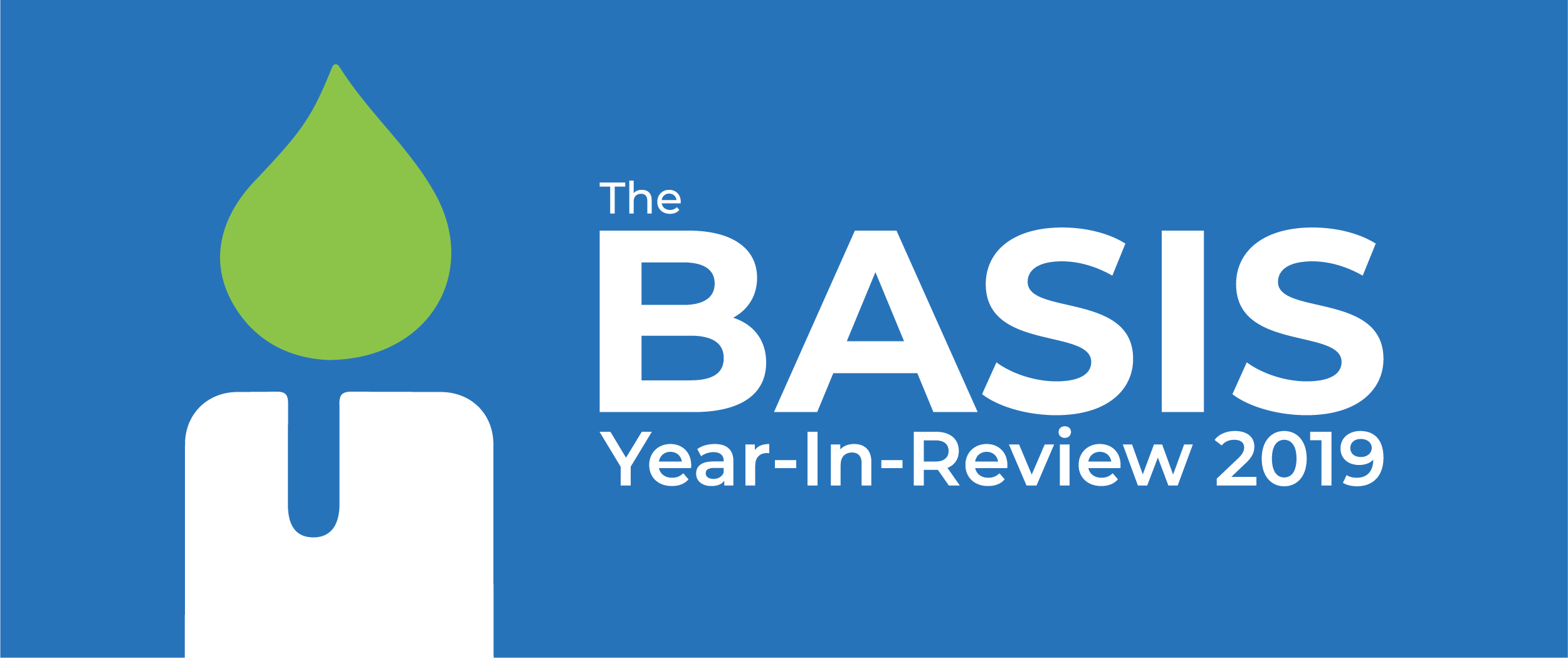The BASIS Year-In-Review: 2019

Another successful year of The BASIS has come to a close. In 2019, we continued to cover important advances in addiction research. We also presented Special Series on Gambling Disorder, Addiction and Stigma, and Addiction and Social Media featuring many insightful op-eds. For instance, former Director of National Drug Control Policy Michael Botticelli and Massachusetts Director of Programs for The Phoenix Sydney Durand explained how stigma affects recovery from addiction. Cyberaddiction experts Dr. Stephanie Diez and Dr. David Greenfield highlighted the dangers of excessive social media use. And Lisa Lundrigan shared the powerful story of her father’s recovery from gambling disorder. In addition, we updated readers on our continuing commitment to open science. Today, we look back on the year with our top five most-read reviews of 2019 and favorites from The BASIS editorial staff.
The Top 5 Most-Read Reviews of 2019
5. The WAGER, Vol. 24(5) – Gambling risk and losses disguised as wins Slot machines often trick players with “losses disguised as wins”: The machine displays celebratory images and sounds when a player gains fewer credits than they wagered. Our fifth-most-read review showed that high-risk gamblers are more likely to continue gambling when shown losses disguised as wins.
4. STASH, Vol. 15(9) – WhatsApp with social media and smartphone messaging apps in the illicit drug market? Young adults use both illicit drugs and social media at high rates compared other age groups. Our fourth-most-read review shared the finding that both young and older adults are experimenting with social media apps as a method for buying and selling drugs, with cannabis being by far the most common drug purchased on these platforms.
3. STASH, Vol.15(1) – Racial disparities in opioid treatment completion across U.S. cities In the United States, racial minorities with substance use disorders experience more barriers to addiction treatment and complete treatment at lower rates than non-minorities. Our third-most-read review found that racial disparities in opioid addiction treatment completion in the U.S. are concentrated in three metropolitan areas, primarily New York City, New York.
2. The WAGER, Vol. 24(7) – From Fortnite to slots: Do problem video gaming behaviors predict future problem gambling behaviors? Young adults are more vulnerable to problem video gaming than older adults, and problems with video games might carry over into problem gambing. Our second-most-read review suggested that some behaviors associated with excessive video game play do in fact transfer over to problem gambling as young adults grow up.
1. The DRAM, Vol. 15(5) – Contingency management for reducing alcohol use Contingency management is a form of addiction treatment that rewards clients for remaining abstinent from a target substance. Our most-read science review of 2019 found that remotely-delivered contingency management treatment for people with alcohol use disorder is feasible and can reduce alcohol consumption.
Editor’s Picks for 2019
ASHES, Vol. 15(11) – The role of flavors in vaping initiation, satisfaction, and addiction This year, e-cigarettes and vaping have dominated headlines. E-cigarettes are an aerosol-based delivery system for nicotine that simulate the experience of combustible-based tobacco smoking (e.g., cigarettes, cigar, hookah), which have traditionally been conceived as a safer alternative and a means to help people quit traditional tobacco smoking. However, they have since evolved into their own distinct form of recreational activity. The enduring popularity of vaping, especially among youth, has given rise to the fear that nicotine addiction  has found its way back into the mainstream. Compounding these fears is the recent spike in acute health effects associated with e-cigarette use and their potential for long-term health effects. At the Division on Addiction, we recognize the importance of this topic, where approximately half of the ASHES reviews this year have covered e-cigarette use in some form. One of those reviews that stood out for me in particular concerned the topic of e-cigarette flavorings. Authored by Jamie Juviler, this review specifically looked at how flavorings influence satisfaction and perceived addiction to e-cigarettes. This review showed that e-cigarette flavorings tend to be associated with vaping initiation as well as vaping satisfaction and addiction. These findings suggest that e-cigarette flavorings in particular might have helped to promote their evolution from traditional smoking alternative to a new form of recreational activity. Notably, policymakers have caught on to this and have begun to initiate bans on e-cigarette flavorings. It will be interesting to see in the coming years whether these types of policies can halt the increasing popularity of vaping, or whether it will continue to flourish in spite of them.
has found its way back into the mainstream. Compounding these fears is the recent spike in acute health effects associated with e-cigarette use and their potential for long-term health effects. At the Division on Addiction, we recognize the importance of this topic, where approximately half of the ASHES reviews this year have covered e-cigarette use in some form. One of those reviews that stood out for me in particular concerned the topic of e-cigarette flavorings. Authored by Jamie Juviler, this review specifically looked at how flavorings influence satisfaction and perceived addiction to e-cigarettes. This review showed that e-cigarette flavorings tend to be associated with vaping initiation as well as vaping satisfaction and addiction. These findings suggest that e-cigarette flavorings in particular might have helped to promote their evolution from traditional smoking alternative to a new form of recreational activity. Notably, policymakers have caught on to this and have begun to initiate bans on e-cigarette flavorings. It will be interesting to see in the coming years whether these types of policies can halt the increasing popularity of vaping, or whether it will continue to flourish in spite of them.
–Timothy Edson, PhD Series Editor, ASHES
 The DRAM, Vol. 15(10) – Alcohol-branded content on Facebook: What does clicking “Like” say about drinking behavior? Social media has been in the news a lot this year, sometimes in a positive light, sometimes in a negative light. At the very least, social media platforms like Facebook give people places to construct and project images of themselves for others to see. In September, Jamie Juviler reviewed a study from Australia looking at teens’ and young adults’ activity on Facebook and any interactions with alcohol brands on the platform. Those who were more active on Facebook were not necessarily more likely to drink more frequently or in heavier amounts. However, those who interacted specifically with alcohol brands on Facebook and those who uploaded or tagged photos showing alcohol products were. On some level, people’s news feeds tend to be reflections of what they are, think, and do — or at least what they’d like to project. Other researchers have discussed the notion of drinking identity (i.e., a person viewing himself or herself as a drinker) and its association with actual issues with alcohol use. People should be aware of the image that they project online. If someone is at least projecting the image of someone who has trouble controlling their drinking, then it’s possible that there are some underlying problems. At the very least, some self-reflection may be in order.
The DRAM, Vol. 15(10) – Alcohol-branded content on Facebook: What does clicking “Like” say about drinking behavior? Social media has been in the news a lot this year, sometimes in a positive light, sometimes in a negative light. At the very least, social media platforms like Facebook give people places to construct and project images of themselves for others to see. In September, Jamie Juviler reviewed a study from Australia looking at teens’ and young adults’ activity on Facebook and any interactions with alcohol brands on the platform. Those who were more active on Facebook were not necessarily more likely to drink more frequently or in heavier amounts. However, those who interacted specifically with alcohol brands on Facebook and those who uploaded or tagged photos showing alcohol products were. On some level, people’s news feeds tend to be reflections of what they are, think, and do — or at least what they’d like to project. Other researchers have discussed the notion of drinking identity (i.e., a person viewing himself or herself as a drinker) and its association with actual issues with alcohol use. People should be aware of the image that they project online. If someone is at least projecting the image of someone who has trouble controlling their drinking, then it’s possible that there are some underlying problems. At the very least, some self-reflection may be in order.
— Matthew Tom, PhD Series Editor, The DRAM
The WAGER, Vol. 24(6) – Differences in stigma across levels of gambling behavior Mental health disorders including addiction are some of the most stigmatized forms of illness. Many who experience problems with addiction never seek professional treatment. One reason for that gap is stigma. And the roots of stigma reach deep into the foundation of our efforts to prevent and treat addiction. Stigma has a significant impact on the course of illness, treatment seeking, and even treatment itself. During May, the Division chose to dedicate a Special Series to exploring how aspects of stigma impact the experience of addiction. For The WAGER, Eric Louderback reviewed a recent study that examined stigma towards people with gambling problems. Respondents reported negative and discriminatory attitudes toward a hypothetical person who showed signs of moderate gambling disorder. Finding significant amounts of stigma for a moderate gambling disorder further confirms what we already know about stigma and addiction. What’s more troubling was that respondents reported a desire for social distance from a person with a diagnosed gambling disorder. Those with mental health conditions need social support from family and friends to help them find the appropriate treatment for them and to help them through their recovery. It’s clear at least in the US that we have much more work to do to be more accepting of those facing addiction.

STASH, Vol. 15(10) – Local trends in adolescent heroin and injection drug use in the United States between 1999 and 2017 We can’t prevent harmful substance use without knowing who’s being hit the hardest. In October, Alessandra Grossman reviewed a recent study exploring local trends in adolescent heroin and injection drug use in the US over the past two decades. The researchers examined Youth Risk Behavior Survey data from 1999 to 2017 in nine urban areas across the US. They found significant increases in lifetime heroin use in New York City, Milwaukee, and Chicago. They also found significant increases in injection drug use in New York City, Orange County and Miami-Dade County. Only San Bernardino showed a significant decrease in lifetime heroin use and injection drug use. While national or even state prevalence rates of substance use might remain stable, this study shows that, at least in urban areas, significant variability exists. There is hope that public health practitioners in these urban areas are hard at work developing community centered and culturally appropriate prevention, intervention, and treatment programs to address the increased heroin and opioid use among youth in our urban communities.
John Kleschinsky, DrPH Series Editor, STASH & The WAGER
Which post was your favorite? Let us know in the comment section below. If you have a topic that you would like to see covered by the BASIS, please share it with us at basis@divisiononaddictions.org.
You can also show your support by making a tax-deductible donation to the BASIS. The Division on Addiction relies entirely on grants, contracts, and gifts to produce all of its work, including The BASIS. With your help, we will continue to advance the public’s understanding of addiction and improve the lives of people affected by addiction. Any amount makes a difference.
Thank you for reading and best wishes for a happy holiday season!
Sincerely,
The BASIS Team
We recognize that the holidays can be difficult for many. Visit The BASIS addiction resources page for screening information or call SAMHSA’s National Addiction Helpline at 1-800-662-HELP (4357) to learn about treatment and referral opportunities.